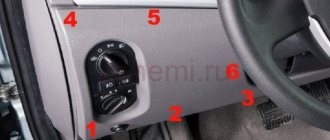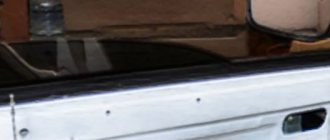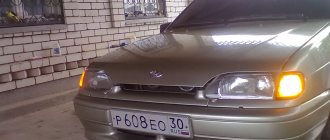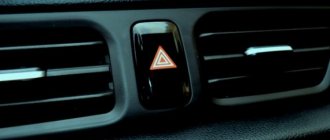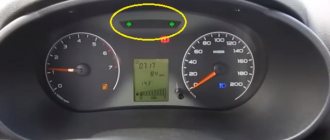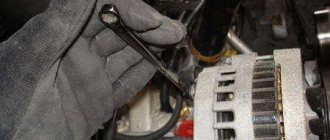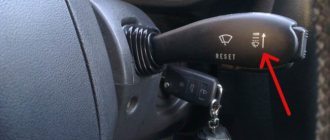During the operation of the car, the driver may encounter various malfunctions. In some cases, it is advisable to contact a service center for repairs, in others, for example, you can deal with a breakdown of Lada Granta turn signals yourself.
If you encounter a problem with your turn signals, follow these instructions:
1. The first thing you should check is whether the turn signal lamps themselves have burned out.
2. Check the “ground” and “power” on the contacts of the turn signal connector using a multimeter or a test lamp.
3. Check the integrity of the turn signal fuse in the mounting block. On the Lada Granta this is fuse F6, which also applies to the reversing light. In some cases, a faulty fuse cannot be identified visually, so replace the fuse to check the turn signal operation in any case.
4. The turn signal relay is also responsible for the operation of the turn signals, which on the Lada Granta is marked K5. Replace the relay with a known good one.
5. On the Lada Granta Luxury there may be a malfunction in the electrical package control unit (central body electronics unit - TsBKE). This block is responsible for a number of functions, including the operation of direction indicators.
6. Check the integrity of the wiring using the Lada Granta electrical diagrams.
Let us remind you that there are other problems that Lada Granta owners face, for example, power windows do not work.
Most electrical circuits in modern cars are protected by fuses. Firstly, this protects the electrical device itself from damage, and secondly, it prevents the threat of fire due to overheating or short circuit.
Replacing Turn Relay Lada Granta
What to do if the turn signals on the Lada Granta do not work
It happens: the Lada Granta made you happy and happy, and then take the turn signals and leave them. And what’s scary in this situation is not the fine, but the danger that arises when changing lanes and turning. Of course, you can also give signals with your hand, but it is much more convenient to use turn signals. Perhaps you have to replace the Lada Granta turn signal relay, maybe you have to replace the lamps. You need to understand everything in detail.
Changing the lamp
So, we have the following task: Lada Granta turn signals do not work. The first step is to check whether the lamp has burned out. Let's say it burned out. This means it needs to be replaced. The front turn signals are equipped with PY21W lamps; you can purchase a new lamp and replace it yourself.
In order to pull out the lamp, you need to press on the socket and turn it. The direction of rotation depends on which side the headlight is located on. If on the right, then turn it clockwise. On the left - against, of course. Next, it should be pulled out of the cartridge. To do this, press the lamp and turn it counterclockwise all the way. Now you can insert a new lamp and return everything as it was.
A W5W lamp is installed in the side turn signal. How to get it? Let's say you are on the right wing. In this case, you need to move the turn signal housing to the right (correspondingly, the left one - to the left) and remove the indicator. The lamp socket rotates counterclockwise. Having taken out the lamp, you can replace it and put everything back together, after inspecting the rubber gasket. If you are not satisfied with it, this is a good time to replace it.
Relay block for VAZ - Lada Granta
This video shows where the relay
on the VAZ
Lada Granta
, and also shows how and where to find the right one...
Turn signals and emergency lights do not work on Grant//relay replacement
Relay clicks
? Then watch carefully, I’ll tell you how to get rid of it in literally 10 minutes. Well, as a...
Everything is fine with the lamp, but the turn signals on Grant still don’t work? Let's move on.
Checking the serviceability of the fuse
This is the next stage of action when the turn signals of the Lada Grant do not work. Now open the mounting block. It is located on the left side of the dashboard. There you will find 32 fuses. For standard cars, the fuse we need is marked F6, which also serves the reversing light.
A malfunction is determined by a burnt-out hair, but it is not always possible to confine yourself to just a visual inspection. Therefore, you need to replace it with a new one. If the old one was faulty, then it is necessary to check the entire circuit (after all, it didn’t just burn out). To do this, you will need a multimeter or a test lamp. For example, the right turn signal of the Lada Granta does not work. You need to ring all the bulbs in this circuit and find a short circuit. The next step is Lada Granta turn signal relay.
Designation and fuse diagram of Lada Granta 2011
Now you need to study the diagram and location of relays and fuses. It looks like this:
I highly recommend going here. And buy a small handful of fuses. Let them ride in the car with you. They are more expensive in the store, and replacement at the service center will cost 200-300 rubles. As a rule, it burns out suddenly , and may not always be at hand. This is where this set will help you out.
How is diagnosis made? Let's say the cigarette lighter doesn't work. We are looking for the fuse that controls the cigarette lighter in the car. According to the diagram below, this is F20 - 15 Amperes. By the way, if the fuse is blown, then the sound signal will not work with it.
- F1 - 15 Amps: Engine ECU, cooling fan, injectors
- F2 - 30 Amps: power windows
- F3 - 15 Amps: “emergency light”
- F4 - 20 Amperes: power supply to the SRS unit (airbags) and windshield wiper
- F5 - 7.5 Amps: relay (terminal 15)
- F6 - 7.5 Amps: reverse light
- F7 - 7.5 Amps: Injection ECU
- F8 - 25 Amps: heated rear window
- F9 - 5 Amps: side light, right side
- F10 - 5 Amp: parking light, left side
- F11 - 5 Ampere: rear PTF
- F12 - 7.5 Amps: low beam - right headlight
- F13 - 7.5 Amps: low beam - left headlight
- F14 - 10 Amp: high beam - right headlight
- F15 - 10 Amp: High Beam - Left Headlight
- F16 - Spare
- F17 - Spare
- F18 - Spare
- F19 - Spare
- F20 - 15 Amps: horn, cigarette lighter, trunk lock, diagnostic connector power supply
- F21 - 15 Amps: fuel pump fuse
- F22 - 15 Amperes: central locking control unit
- F23 - 10 Amps: DRL lamps
- F24 - Spare
- F25 - 10 Amperes: interior lamp, brake light
- F26 - Spare
- F27 - Spare
- F28 - Spare
- F29 - Spare
- F30 - Spare
- F31 - Spare
- F32 - 30 Ampere: EUR, Climate control, air conditioning
Checking the relay
Where is the Grant turn signal relay located? Everything is in the same mounting block. Marking K5.
How to replace the turn signal relay on a Lada Grant? It can be removed using a puller located in the mounting box, and then a known-good unit can be placed in the free space. If everything works with the new relay, then the problem is solved. However, even before searching for a burnt-out lamp, you can check the Lada Granta turn signal relay.
If you are faced with the fact that the turn signals on your Grant are constantly on, then this probably indicates that something is shorting somewhere. You need to test the circuit with a multimeter. Sometimes in this case it is possible to establish the influence of emergency lights and even signaling. Remember if you changed anything there before the problems with the turn signals appeared.
Another common problem is the situation when the turn signals on a Lada Granta do not work, but the emergency lights do work. It is necessary to check whether everything is in order with the emergency button. It happens that the button simply moves away. It needs to be given a normal position, and the turn signals will work.
Malfunctions of turn signals on Lada Granta Lux
A separate story is the problems with cars of this design. When the turn signal on a Grant Lux does not work, the problem may be with the microcircuit located in the TsBKE unit. It does not have a voltage reserve, which leads to the question: “Why do the turn signals on Grant constantly light up.” Here's why: there was a short circuit there. The problem is solved by replacing the CBKE. By the way, this unit is located in the cabin, under the front panel.
Source
If the Lada Granta turn signals do not work
During the operation of the car, the driver may encounter various malfunctions. In some cases, it is advisable to contact a service center for repairs, in others, for example, you can deal with a breakdown of Lada Granta turn signals yourself.
If you encounter a problem with your turn signals, follow these instructions:
1. The first thing you should check is whether the turn signal lamps themselves have burned out.
2. Check the “ground” and “power” on the contacts of the turn signal connector using a multimeter or a test lamp.
3. Check the integrity of the turn signal fuse in the mounting block. On the Lada Granta this is fuse F6, which also applies to the reversing light. In some cases, a faulty fuse cannot be identified visually, so replace the fuse to check the turn signal operation in any case.
4. The turn signal relay is also responsible for the operation of the turn signals, which on the Lada Granta is marked K5. Replace the relay with a known good one.
5. On the Lada Granta Luxury there may be a malfunction in the electrical package control unit (central body electronics unit - TsBKE). This block is responsible for a number of functions, including the operation of direction indicators.
6. Check the integrity of the wiring using the Lada Granta electrical diagrams.
Let us remind you that there are other problems that Lada Granta owners face, for example, power windows do not work.
Source
Main symptoms of a malfunction
If you find a blown fuse, there is no need to rush and change it as soon as possible; try to find the reason that led to the burnout. Each of the fuses is responsible for one specific circuit, therefore, by calculating this circuit, you can accurately determine the faulty element. If a repeated breakdown occurs after replacing the burnt-out device, it is recommended to immediately seek help from an electrician.
Thus, if you identify any breakdown associated with the electrical equipment of the car, you must immediately check the condition of the fuses and relays, replace them if they burn out, but before that, be sure to find out the cause of the malfunction.
If you independently determine the faulty circuit, you will need to remove the cover of the mounting block. On its inside you will see a correct and current diagram for installing fuses, based on which you can calculate the faulty circuit. Grant's electronics circuit looks like this:
| Fuse | Current strength, A | Protected circuit |
| F1 | 15 | — Relay for turning on the engine cooling fan — Short circuit 2x2 — Controller (engine control unit) — Injectors — Ignition coil |
| F2 | 30 | Electric windows |
| F3 | 15 | Alarm |
| F4 | 20 | — Windshield wiper — Airbag |
| F5 | 7,5 | Ignition switch terminal 15 |
| F6 | 7,5 | Reversing light |
| F7 | 7,5 | — Canister valve — Mass air flow sensor — Oxygen sensor 1/2 — Speed sensor |
| F8 | 30 | Rear window defroster circuit |
| F9 | 5 | Side lights on starboard side |
| F10 | 5 | Side lights on the left side |
| F11 | 5 | Rear fog lights |
| F12 | 7,5 | Low beam on starboard side |
| F13 | 7,5 | Low beam on the left side |
| F14 | 10 | High beam on starboard side |
| F15 | 10 | High beam on the left side |
| F16 | 10 | Front fog lamp on starboard side |
| F17 | 10 | Front fog lamp on the left side |
| F18 | 15 | Heated front seats |
| F19 | 10 | ABS (Anti-lock Braking System) |
| F20 | 15 | — Horn — Trunk lock — Transmission — Cigarette lighter — Diagnostic connector |
| F21 | 15 | Electric fuel pump |
| F22 | 15 | central locking |
| F23 | 10 | Daytime Running Lights |
| F24 | 7,5 | Air conditioner |
| F25 | 10 | — Interior lighting — Brake light |
| F26 | 25 | Anti-lock braking system |
| F27 | — | Spare |
| F28 | — | Spare |
| F29 | — | Spare |
| F30 | — | Spare |
| F31 | 50 | Heated windshield |
| F32 | 30 | — Heater — Electric power steering |
| Relay | Description |
| K1 | Heater fan relay. |
| K2 | Power window relay |
| K3 | Starter relay |
| K4 | Ignition switch terminal 15 relay |
| K5 | Turn signal and hazard warning relay |
| K6 | Wiper relay |
| K7 | High beam relay |
| K8 | Horn relay |
| K9 | Low beam relay |
| K10 | Heated rear window relay |
| K11 | Controller relay (engine control unit) |
| K12 | Electric fuel pump relay |
Lada Granta mounting block under the hood:
| F1, 50A | Electric power steering; |
| F2, 30A | Heater fan |
| F3, 60A | Generator |
| F4, 60A | Generator |
| F5, 30A | Dipped headlights. |
New family
(from September 2022):
Before removing a burnt-out device, be sure to turn off the power to the car by disconnecting the wire connected to the “negative” terminal from the battery. When replacing a fuse, it is recommended to use pliers or special pliers and tweezers. Once you open the lid, you will quickly recognize a blown element - it will clearly stand out against the background of working fuses. Remove it using tweezers, and then insert the new part into its proper place.
If a fuse frequently blows, you should think about the correct functioning of the entire circuit, and perhaps seek help from specialists. It is not recommended to make independent changes to the scheme.
Types of problems and troubleshooting methods
The turn signal works correctly if the following indicators are met:
- the presence of the ignition on ensures the operating mode;
- moving the steering column switch up and down must be accompanied by turning on the turn signal on the corresponding side;
- The turn signal should flash at a rate of 60 cycles per minute.
Flashing at a certain frequency
Any other behavior of the turn signal indicates a problem. The most common causes of malfunctions include:
Non-blinking turn signal. The problem requires familiarity with the basic principle of relay operation: the current passing through the lamps leads to heating of the measuring resistor - an element that determines whether a particular lamp needs to be turned on. Consequently, the lamp resistance, different from the nominal one, changes the time the turn signal is turned on: it begins to blink. In this situation, it is recommended to lightly tap the relay (this helps if there is a weak connection or moisture). If you have replaced the relay, but the turn signal does not blink, but is constantly on, then there is poor contact with the fuse block. Replacing a fuse that was found to have a resistance value that does not correspond to the nominal value can also help.
Useful tips
If the fuse constantly blows, then this is a reason to think about the correct operation of this circuit. We also do not recommend making changes to the design unless absolutely necessary.
Recently, LED automobile lamps have become used. They are more durable and consume less current. The latter precisely affects the operation of the turn relay, changing its frequency. The frequency of relay operation is tied to the load resistance, that is, to the installed lamps. As the load resistance increases, which is exactly what happens when one of the lamps burns out or opens, the relay begins to operate most often. The same effect is observed when installing LEDs in direction indicators, since their power consumption is less, which means the resistance is much greater.
After studying the material in this article, you will be able to modify the standard turn signal relay for LEDs so that it operates at the frequency you need.
First of all, a little about the standard relay. The 3-pin turn signal relay which will be discussed is installed on cars starting from VAZ 2108 to the present, that is, on VAZ 2109, 2110, 2111, 2112, Lada Priora, Lada Kalina, GAZ cars. Marking 495.3747-ХХ.
To modify the relay, it will be necessary to open the housing. To do this, take a flat-blade screwdriver and remove the housing cover by pulling the plastic latches from two opposite sides.
Now let’s figure out what is responsible for what in this circuit and how we can change the operation so that with increased load the frequency of operation of the direction indicators does not change. The first is connection. Ground is connected to pin 31. 49a - output to lamps, 49 - input “+” from the turn signal switch.
R3 is a current-limiting resistor to the control base of the transistor in the microcircuit; R1 and C11 - these are the radio elements that are responsible for the frequency of the output signal from pin 3 of the microcircuit. From leg 3 power is supplied to the relay winding; Conclusion 7 is also an interesting conclusion. The output controls the change in resistance and, accordingly, voltage at contact 49 a. It is he who gives the command to the microcircuit to change the frequency when the lamps burn out. The microcircuits can be not only those indicated on the diagram, but also, for example, KR1055GP1B , etc. analogues.
Now, presenting the functional purpose of the relay elements, it is not difficult to decide on measures to maintain the frequency of operation of the direction indicators when their internal resistance changes, that is, for example, when installing LEDs.
Video
How to diagnose a faulty turn signal, see below:
Optics play an important role when driving a car - any malfunction of the lights can create an emergency situation on the road. Turning lights are no exception, they are used both to indicate the direction of turn and for emergency lighting. It is about turn signals that we will talk today in this article, and to be more precise, about their malfunctions.
The design of turning lights is quite simple - wires are connected to the lamps through a fuse and a relay. The relay is turned on by the hazard warning button or the steering column switch. As a rule, a separate relay is installed for each direction of rotation, and a separate one for the emergency lights. Symptoms of malfunction vary in each individual case.
How to select and replace a relay on Kalina
A relay in a car is used to remotely control consumers that require high currents.
For example, to activate the starter, the ignition switch contacts and its wiring will not be enough. Therefore, the lock serves only as a control device, and the relay closes the power contacts and the retractor relay circuit.
In cars of both generations, the most common 4 and 5-pin relays are used. However, two types of sizes are used here; this should be taken into account when selecting. It is better to look at the characteristics of the relay on the body and buy exactly the same one or show the required relay to an auto parts dealer. Automotive relays can vary in current strength, number and location of contacts.
To replace faulty relays and fuses on the Lada Kalina, use a special “pliers” tool, which is installed in the lower right corner. The larger ones are for relays, and the smaller ones are for fuses.
If, after replacing the fuse, it has blown again, you should not try to change it again; most likely there is a short circuit in the circuit and the car must be sent for more thorough diagnostics.
Turn signals don't work
The most common cause of turn signal failure is failure of the lamps themselves. In this case, the resistance of the circuit decreases, as a result of which the frequency of operation of the relay is sharply reduced - this can be noticed immediately after the lamp fails. What to do if this happens while driving:
- Find a place to stop so as not to interfere with traffic
- Turn on the turn signal and see which of the three lamps has failed
- Unscrew the light bulb and check the integrity of the filament
- Replace the lamp if necessary. The lamps are sold in every store and are universal for almost all cars - be it a VAZ or a foreign car.
Headlight switch relay
The headlight switching relay is designed to switch the high and low beam of headlights and to briefly turn on the high beam of the headlights. The use of relays in headlight control circuits allows you to extend the service life of contacts, which, when directly switching circuits of switches and headlight lamps, burn out much faster, since they pass a relatively large current.
Let us consider the fundamental design and operation of such a relay using the example of the PC711 headlight switching relay (Fig. 5).
Emergency lights don't work
The main reason for the malfunction of the emergency lights is the failure of the relays and fuses. Sometimes this also happens due to poor-quality installation of the alarm system, since its operation is tied to these lights (in some cases, the “signal light” is connected to the side lights).
Thanks for subscribing!
The failure of the hazard warning lights is not as critical as the failure of the turning lights. However, if the car malfunctions at night on unlit roads, the emergency lights will greatly protect the situation.
The algorithm of actions in the event of a malfunction of the hazard warning lights is the same as with turn signals, except that the bulbs need not be checked - simultaneous failure of all 6 bulbs is not possible.
It happens: the Lada Granta made you happy and happy, and then take the turn signals and leave them. And what’s scary in this situation is not the fine, but the danger that arises when changing lanes and turning. Of course, you can also give signals with your hand, but it is much more convenient to use turn signals. Perhaps you have to replace the Lada Granta turn signal relay, maybe you have to replace the lamps. You need to understand everything in detail.
Conclusion
The turn relay is a small but extremely important component of a car's warning light system. It allows the driver to be more predictable for other road users, which, of course, has the best effect on traffic safety and, to some extent, comfort. If the relay fails, the problem cannot be ignored under any circumstances. Fortunately, the relay is not an expensive component of lighting systems, so a car enthusiast can take two devices at once with almost no loss of budget - the second one will be in the trunk, garage or at home in reserve. This is exactly what we advise you to do.
Source
Self-diagnosis of car lighting devices
There are several situations in which you can determine that optics need diagnostics:
- The turns do not flash, but light up. Such a malfunction indicates the failure of the relay, in particular, we are talking about its electromagnetic component. The electromagnet itself could close in one of the positions, as a result of which it cannot return to its initial state.
- The turning lights flash very quickly or very slowly. In this case, the problem may lie not only in the relay. In some cases, this type of malfunction occurs when the driver uses inappropriate lighting sources. So when purchasing new light bulbs, you need to make sure that they correspond to the rating set by the car manufacturer.
- The optics don't work at all. That is, the turning light bulbs do not flicker, and the corresponding indicators on the dashboard also do not light up. In addition, there are no characteristic clicks that appear when turning on the turning lights. With such symptoms, there can be many reasons for the problem; we will tell you more about their diagnosis below (the author of the video is the Steel Horse channel).
This is interesting: Broken timing belt and possible consequences - causes, symptoms, repair As for diagnostics, it is performed in several stages:
- First of all, you need to make sure that all sensors and indicators on the device are working. If they do not function, then it is necessary to diagnose the safety devices.
- If all devices are operating in normal mode, then you next need to turn on the light alarm button and diagnose all light sources in the headlights. That is, check the front, rear, and side (if any) lights.
- If the alarm does not function when activated, you need to check the functionality of the relay, and also check the power supply at the terminals. To do this, remove the relay from its mounting location, and then, using a test light, connect one of its contacts to the installation site (to the positive), and the other to the car body or battery. There is no need to turn on the ignition. If there is no power, then most likely the reason lies in a failed safety device, a broken hazard warning button, or a damaged electrical circuit. Also, the essence of the problem may lie in poor contact in the connecting plugs.
- If there is a plus on the contacts, then try shorting the two relay terminals using copper wiring. If all electrical circuits, as well as the connection plugs, are working properly, then all turn signals should light up. In this case, the fault must be looked for in the relay.
- If the lights do not light up after the steps you have performed, then most likely the cause of the malfunction lies in the emergency light control button. However, in practice this happens quite rarely; there is often a short circuit in the circuit. By the way, it is a short circuit that can lead to a breakdown of the relay, therefore, before replacing the failed element, you need to eliminate the short circuit.
- If the emergency signal is functioning, this indicates that the safety devices and relays are working; accordingly, you need to start diagnosing the button itself. First of all, you need to diagnose the positive terminal, as in the case of checking the relay, while the ignition, as well as the hazard warning button, must be activated. If the diagnostics showed that there is no plus, this indicates that the button itself needs to be checked in more detail. Remove it from its seat and check the connection circuit. If there is no power, then you need to look for a break in the wiring from the tidy to the button itself. If there is power, then it will be necessary to short-circuit the terminals at the installation site, the ignition does not turn off, after which the direction indicators must be activated (on either side). When the lighting sources are turned on, the control button must be replaced, but if there is no power, then you need to check the power in the emergency relay. If there is no power, the problem most likely lies in a break in the connecting electrical circuit from the control key to the block with safety devices.
What causes fuses to blow in Grant
Automotive fuse links are used to protect electrical circuits:
- From short circuits;
- From overloads;
As a rule, the most common malfunction is an overload of the electrical circuit. For example, a powerful device connected to a car's cigarette lighter will easily blow out the corresponding fuse.
It is not recommended to increase the fuse rating by more than 5A to avoid serious stress on the contacts and wiring.
If you put a 30A fuse together with a 15A fuse, then the wires in the electrical circuit will start to heat up, the insulation will melt, and all this will lead to a fire.
Short circuits rarely occur, but they also occur. As a rule, these are mechanical damage to the wiring. For example, a positive wire laid along the body was damaged by another element of the car as a result of a minor accident. Naturally, the insulation was damaged and the “plus” shorted to ground, which led to the burnout of the insert.
Short circuits can occur not only as a result of an accident, but also as a result of manufacturing defects, as well as the negligence of the car owner when connecting any devices.
Changing the lamp
So, we have the following task: Lada Granta turn signals do not work. The first step is to check whether the lamp has burned out. Let's say it burned out. This means it needs to be replaced. The front turn signals are equipped with PY21W lamps; you can purchase a new lamp and replace it yourself.
In order to pull out the lamp, you need to press on the socket and turn it. The direction of rotation depends on which side the headlight is located on. If on the right, then turn it clockwise. On the left - against, of course. Next, it should be pulled out of the cartridge. To do this, press the lamp and turn it counterclockwise all the way. Now you can insert a new lamp and return everything as it was.
A W5W lamp is installed in the side turn signal. How to get it? Let's say you are on the right wing. In this case, you need to move the turn signal housing to the right (correspondingly, the left one - to the left) and remove the indicator. The lamp socket rotates counterclockwise. Having taken out the lamp, you can replace it and put everything back together, after inspecting the rubber gasket. If you are not satisfied with it, this is a good time to replace it.
Checking the serviceability of the fuse
This is the next stage of action when the turn signals of the Lada Grant do not work. Now open the mounting block. It is located on the left side of the dashboard. There you will find 32 fuses. For standard cars, the fuse we need is marked F6, which also serves the reversing light.
A malfunction is determined by a burnt-out hair, but it is not always possible to confine yourself to just a visual inspection. Therefore, you need to replace it with a new one. If the old one was faulty, then it is necessary to check the entire circuit (after all, it didn’t just burn out). To do this, you will need a multimeter or a test lamp. For example, the right turn signal of the Lada Granta does not work. You need to ring all the bulbs in this circuit and find a short circuit. The next step is Lada Granta turn signal relay.
Mounting block located under the hood
In addition to the fuse box described above, Grants have another device with similar functionality, located under the hood of the car. The fuses included in it, called power fuses, protect the following elements of the machine:
- stove fan;
- generator;
- headlights responsible for low beam;
- electric power steering.
This unit looks like a box installed in a vertical position and is located next to the battery and coolant reservoir. Getting to the power fuses is easy - remove the top cover from the mounting block and you will have direct access to all elements of the block.
Do-it-yourself repair of direction indicators and hazard alarms
If the turns disappear, as well as the car’s emergency signal, then you can try to solve this problem yourself:
- If the safety element and relay break down, the failed parts must be replaced. If the reason lies in a short circuit, then before replacing it is necessary to check all electrical circuits in which it could occur. Only after the cause of the short circuit and power surges has been eliminated, the devices need to be changed.
- If the hazard warning button is faulty, you just need to replace it. We have already talked about how to diagnose this part.
- As for electrical circuit diagnostics, it is carried out using a tester. If damaged sections of the wire are identified, they must be replaced. When laying them, make sure that the wiring does not come into contact with moving body elements. It is also recommended to additionally insulate new wires to increase the reliability of the insulation.
- If the reason is the light bulbs, then all burnt out light sources must be replaced. In the front and rear headlights, the lamps are changed by removing the protection from the headlights, disconnecting the power circuit from the lamp, as well as unscrewing the light source from the seat and replacing it with a new one. If the lamps in the side headlights do not work, then, as a rule, to dismantle the lighting sources, the lamp itself must be pryed off with a screwdriver, then disconnect the power cord and remove the device.
- If the reason lies in the steering column switch, then this device needs to be disassembled and checked. As a rule, the cause of switch failure is poor contact or abrasion. In this case, the failed switch is replaced with a new one. As for the contacts (no matter where - on connections or buttons), it is advisable to clean them.
- You should also check all the plugs and connectors, because it is quite possible that the problem is poor contact on them. Acidified contacts must be cleaned with a wire brush or sandpaper. If the contacts are burnt out, they will need to be replaced.
Turn switch
Another, no less important, element of the turn signal system is the switch on the steering column. It is usually reliable, but given the frequency of its activation, especially in urban traffic, it often fails.
In order to replace it, you need to remove the plastic steering column protection cover. The switch is usually secured with latches, sometimes with screws. Dismantling is not difficult.
Some craftsmen undertake to repair them. It’s better to change it right away, maybe for a used one, if there is no other option.
Turns relay
Until recently, the main element of turn signal and hazard signal systems was the turn relay. In the middle of the last century, turn relays with a bimetallic plate were used. In some models of budget cars and trucks they are still used to this day. Along with simplicity and low cost, they are more reliable and maintainable. A typical relay circuit is shown in the figure:
This is interesting: What to do and what the fine is if the license plate light does not light up
The core of the circuit is a bimetallic strip. It is included in the circuit of current flow through the turn lamps. When turning on the turns or emergency lights, it is in a non-heated state, and closes the circuit of the warning lights, they turn on. As the bimetallic plate is heated by the flowing current, it changes its geometric dimensions (bends).
A little physics: a bimetallic plate consists of two (bi) bonded plates with different coefficients of thermal expansion. When both plates are heated, one expands more, the other less, hence the deformation. When bending, the plate opens the relay contact, the current stops flowing, the lamps go out, the plate cools down again, the contacts close, the lamps light up, the plate heats up... So ad infinitum. If one of the lamps burns out, the current will be less, the plate will heat up more slowly, and the blinking period will increase. If there is a short circuit in the circuit, the lamps will flash quickly. Everything is very simple, reliable and informative. Such relays have been used for more than half a century.
Nowadays, combined relays with a built-in electronic circuit are used.
P O P U L A R N O E:
Switching circuit for car signals and/or lamps
For sound and light effects, you can assemble a simple circuit using three transistors.
It can be used anywhere: on a car, on a motorcycle, on a scooter…. and also on toy cars or, for example, to scare away unwanted guests (thieves) in the country!
It's drizzling. I turn on the windshield wiper. Two or three cycles of brush operation, and the windshield becomes dry. I turn off the windshield wiper. But after 30 seconds the glass becomes dirty again. I turn the windshield wiper, etc. back on.
This mode of operation is not rational for either the front windshield wiper or the rear one. The latter in this case often works “dry”, since fewer raindrops fall on the rear window (although this is compensated by a large amount of dirt). However, intermittent windshield wipers have been known for quite some time. Therefore, the proposed system is of certain interest for all vehicles, given its low cost. Read more…
How to protect the body of your car from corrosion without overpaying a car mechanic.
Since I am an avid motorist, I am interested in everything related to cars. Every car owner is faced with the task of protecting the car body from corrosion. I had read about this original method before; back at the beginning of the last century it was used to protect ship hulls. But this is the first time I have encountered the commercial application of such a miracle technology. While reading advertisements in newspapers, I came across an advertisement for “Electrochemical protection of the car body against corrosion.” After reading the short article, I decided to find out more in the car service center itself. Read more…
Checking the relay
Where is the Grant turn signal relay located? Everything is in the same mounting block. Marking K5.
How to replace the turn signal relay on a Lada Grant? It can be removed using a puller located in the mounting box, and then a known-good unit can be placed in the free space. If everything works with the new relay, then the problem is solved. However, even before searching for a burnt-out lamp, you can check the Lada Granta turn signal relay.
If you are faced with the fact that the turn signals on your Grant are constantly on, then this probably indicates that something is shorting somewhere. You need to test the circuit with a multimeter. Sometimes in this case it is possible to establish the influence of emergency lights and even signaling. Remember if you changed anything there before the problems with the turn signals appeared.
Another common problem is the situation when the turn signals on a Lada Granta do not work, but the emergency lights do work. It is necessary to check whether everything is in order with the emergency button. It happens that the button simply moves away. It needs to be given a normal position, and the turn signals will work.
Replacing the turn relay on Grant
- First of all, we find and remove the protective cover of the fuse box (mounting block). To do this, you need to snap off the special latches. It is best to start the removal process from the upper left corner. Pick up the corner of the cover, apply force and remove the fastening clamp from the groove. Pull the decorative element towards you.
- After all the latches have come out of the grooves, do not make sudden movements or yank the body of the decorative cover. The thing is that there is a trunk opening button on the body, to which a contact chip with wires is attached. Therefore, in order not to damage the contacts and carry out further work, the chip must be disconnected from the button connector.
- After dismantling the decorative cover, we get free access to the mounting block with fuses and relays. Please note that a special plastic puller is provided for removing fuses, which greatly facilitates the entire process of work. To remove the relay, the mounting block contains the same puller, only of a larger size. In addition, on the back (inner) side of the decorative cover there is a diagram with detailed identification of all internal components, which is very convenient when working.
- All elements in the mounting block have their own markings. The product called “K5” is responsible for the operation of turn signals and hazard warning lights.
- The relays in the block are installed quite reliably and in order to replace them you will need to use some physical force. It is best to dismantle the part using a puller. However, quite often, it is not possible to remove the relay even when using it. The ideal solution for such cases is to use pliers.
- Reinstalling the cover is a little more complicated than removing it. Don't forget to connect the contact chip to the connector of the rear trunk release button. We recommend starting installation from the bottom right side. Place the rightmost latch into the hole, then do the same with the central and leftmost latch. After that, move to the upper fasteners and carry out similar manipulations. With a simple push, snap the decorative cover onto the panel.
- This completes the removal and installation process.
Mounting block in the cabin
This mounting block is located to the left of the steering wheel, at the driver’s foot, not far from the light switch. Grants are equipped with a list of fusible, disposable fuses with the same marking with the letter “F” and their own serial numbering (from 1 to 32), the relay is designated with the letter “K”.
To remove the cover and gain access to the relays and fuses, you need to pull the left side of the bottom of the cover toward you, releasing the locking point on the left from the latches. Next, you will need to release the locking point located in the middle, then 2 more points located on the right. Once the top points are released, the cover can be removed without any problems.
Install the fuse box cover like this: first you need to snap its right edge, then it snaps in from the bottom, and, last but not least, from the top. When installing it, you must constantly ensure that the latches match exactly with the cover fastening elements.
Tips for motorists
Passenger cars Lada Granta (VAZ-2190) are produced in three trim levels: normal, standard, luxury. After turning on the turn indicators of the Lada Granta in the norm and standard configurations, the flashing mode of operation of the lamps on the right or left side of the car is provided by the K5 relay installed in the mounting block located in the front panel to the left of the steering column. And in the luxury configuration of the Lada Granta, the direction indicators are provided with a flashing operating mode using a microcircuit (chip) installed in the TsBKE unit (central body electronics unit).
Source
